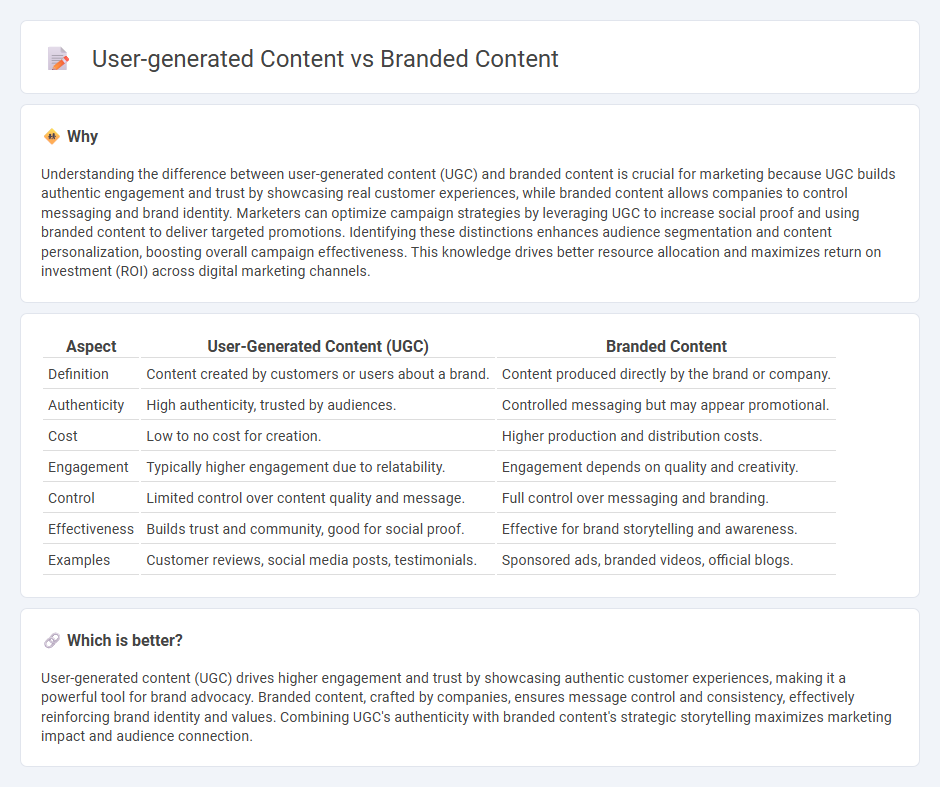
User-generated content leverages authentic customer experiences, creating trust and engagement with organic reach across social media platforms. Branded content, crafted by companies, focuses on strategic messaging to reinforce brand identity and drive targeted campaigns. Explore how combining both approaches can maximize your marketing impact.
Why it is important
Understanding the difference between user-generated content (UGC) and branded content is crucial for marketing because UGC builds authentic engagement and trust by showcasing real customer experiences, while branded content allows companies to control messaging and brand identity. Marketers can optimize campaign strategies by leveraging UGC to increase social proof and using branded content to deliver targeted promotions. Identifying these distinctions enhances audience segmentation and content personalization, boosting overall campaign effectiveness. This knowledge drives better resource allocation and maximizes return on investment (ROI) across digital marketing channels.
Comparison Table
| Aspect | User-Generated Content (UGC) | Branded Content |
|---|---|---|
| Definition | Content created by customers or users about a brand. | Content produced directly by the brand or company. |
| Authenticity | High authenticity, trusted by audiences. | Controlled messaging but may appear promotional. |
| Cost | Low to no cost for creation. | Higher production and distribution costs. |
| Engagement | Typically higher engagement due to relatability. | Engagement depends on quality and creativity. |
| Control | Limited control over content quality and message. | Full control over messaging and branding. |
| Effectiveness | Builds trust and community, good for social proof. | Effective for brand storytelling and awareness. |
| Examples | Customer reviews, social media posts, testimonials. | Sponsored ads, branded videos, official blogs. |
Which is better?
User-generated content (UGC) drives higher engagement and trust by showcasing authentic customer experiences, making it a powerful tool for brand advocacy. Branded content, crafted by companies, ensures message control and consistency, effectively reinforcing brand identity and values. Combining UGC's authenticity with branded content's strategic storytelling maximizes marketing impact and audience connection.
Connection
User-generated content (UGC) and branded content intersect by amplifying authentic consumer voices while maintaining brand messaging consistency. UGC fosters trust and engagement through genuine customer experiences that complement strategically crafted branded content. This synergy enhances brand credibility and drives organic reach across digital marketing channels.
Key Terms
Authenticity
Branded content often emphasizes polished storytelling and strategic messaging to build brand identity, while user-generated content (UGC) thrives on raw, authentic voices that foster genuine consumer trust and engagement. Authenticity in UGC resonates more deeply with audiences by showcasing real experiences and unbiased perspectives, which can enhance brand loyalty and credibility. Explore how leveraging both branded content and user-generated content creates a balanced, authentic connection with consumers.
Control
Branded content offers companies complete control over messaging, design, and distribution, ensuring consistent brand identity and strategic communication aligned with marketing goals. User-generated content (UGC) lacks this control but provides authentic, diverse perspectives that enhance consumer trust and engagement through organic promotion. Explore further to understand how balancing control and authenticity can optimize your content marketing strategy.
Engagement
Branded content, crafted by companies, often drives high engagement through polished storytelling and clear brand messaging, increasing audience trust and loyalty. User-generated content (UGC) fosters authentic interaction and community participation, leading to organic reach and deeper emotional connections with the brand. Explore the nuances of both to maximize your engagement strategy effectively.
Source and External Links
5 Ways to Create Fantastic Branded Content - Branded content is any non-promotional content created by a brand that aims to engage and entertain audiences while subtly representing the brand's identity.
Branded Content Definition: 3 Content Marketing Examples - Branded content is a marketing strategy that tells a brand's story and builds awareness by selling an idea or feeling rather than directly pushing a product.
Branded Content Examples - Branded content is typically produced through sponsored partnerships, focusing on entertainment, information, or education to engage audiences and associate the brand with shared values.
 dowidth.com
dowidth.com